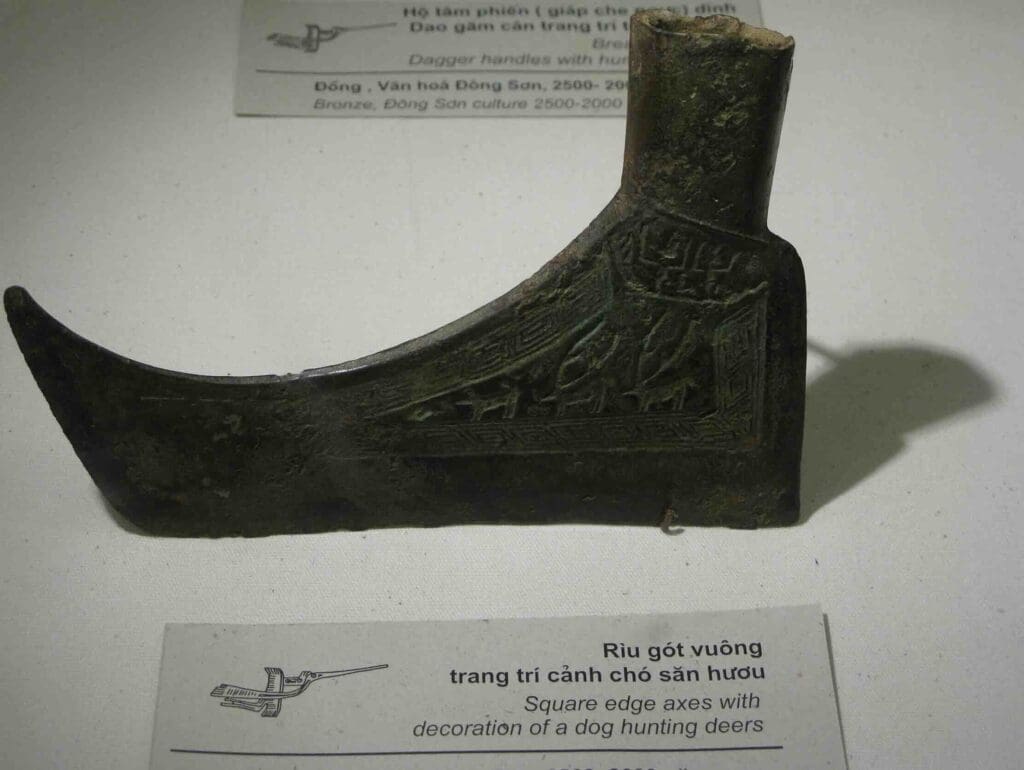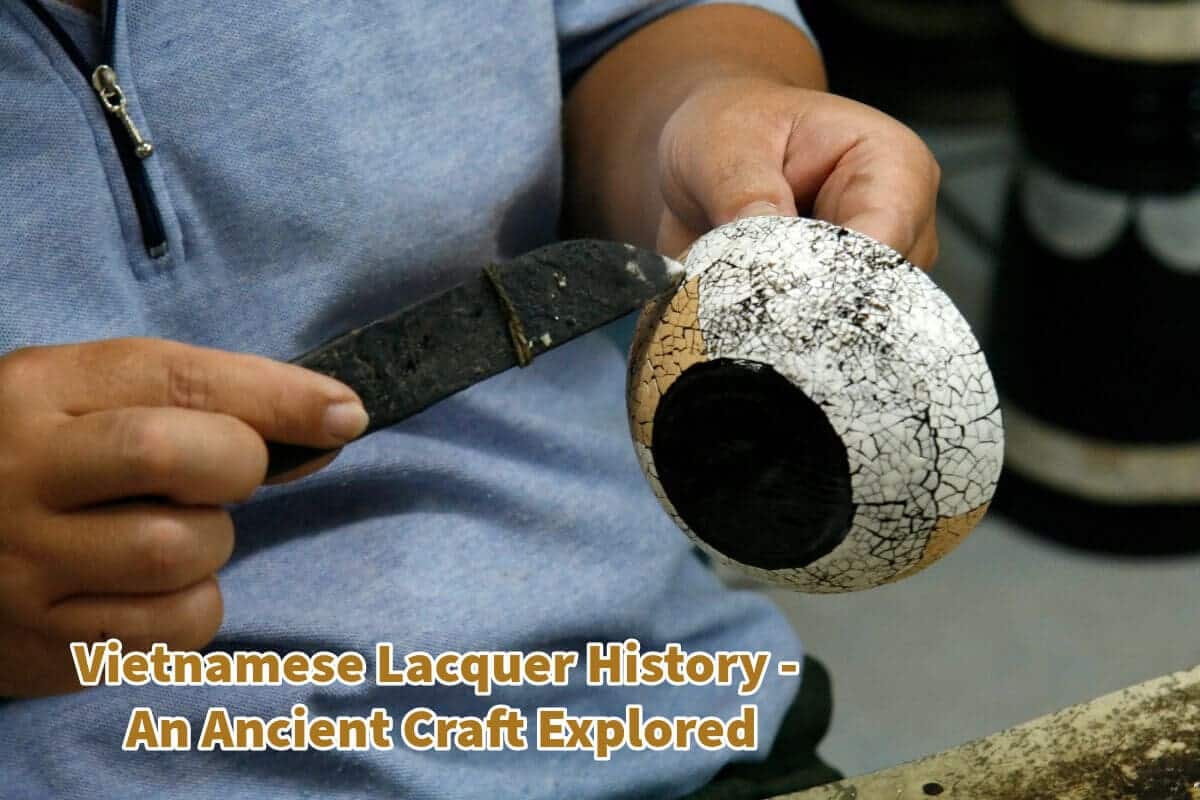In the rural areas surrounding Hanoi, Vietnam, villages with a legacy of lacquer production spanning several centuries.
This enduring Vietnamese lacquerware tradition testifies to the ancient roots of Vietnamese lacquer art, which has been integral to the country’s culture and handicrafts for thousands of years. Owing to this rich history, Vietnamese artisans have developed exceptional skills in lacquerware. Continue reading as we delve into the captivating history of Vietnamese lacquer painting and production.
Table of Contents
- The Evolution Of Vietnamese Lacquer Painting: From Ancient Craft To Contemporary Art
- A Deep-Rooted Tradition: Lacquer In Vietnamese Culture
- Sơn Mài Or Lacquerware Today: The Modern Manifestations
- Related Content
The Evolution Of Vietnamese Lacquer Painting: From Ancient Craft To Contemporary Art
Vietnamese lacquer painting, known as “sơn mài,” may seem like a relatively modern art form that gained prominence in the 1930s, but its roots stretch deep into history. While the technique of using lacquer for decorative purposes goes back 8,000 years to ancient China and Persia, Vietnam has had its unique engagement with lacquer for over 2,000 years.
Initially used to embellish household and religious objects, the art form was revived in the 20th century, transforming into a sophisticated fine art. Read on as we delve into the fascinating journey of Vietnamese lacquer painting, from its ancient origins to its modern-day interpretations.
A Collision Of Time: Young Art Meets Ancient Technique
Although sơn mài as we know it today began its life in the 1930s, it builds on a much older legacy. This form of lacquer painting was significantly influenced by the École Supérieure des Beaux-Arts de l’Indochine in Hanoi, founded by French artists.
Inspired by modern Western art, teachers like Joseph Inguimberty and Nguyễn Gia Trí encouraged their students to explore lacquer painting techniques. The outcome was a blend of traditional craftsmanship and contemporary artistic visions.
From Functionality To Aesthetic Brilliance
Lacquer was initially used for its practical attributes—its resistance to water, heat, and decay made it ideal for crafting durable items. Over time, the aesthetic potential of lacquer began to be explored more intensively.
Religious structures, temples, and household objects started featuring lacquered decorations. This transformation marked the shift from lacquer being a valuable material to a medium for artistic expression.
A Deep-Rooted Tradition: Lacquer In Vietnamese Culture
Lacquerware in Vietnam isn’t just a recent phenomenon. It dates back to the Dong Son culture more than 2,000 years ago. Found in ancient tombs and as relics from the Ly dynasty (11th century), lacquer has been a critical component of Vietnamese culture and art.

Some of the most captivating instances include lacquered objects recovered from shipwrecks that belonged to the Nguyen Lords—these items remained remarkably preserved despite being submerged in salt water for over a century.
The Mystique Of Lacquer Production
The knowledge of lacquer production has always been a closely guarded secret, passed down through families and artisan clans. These artisans held high social status and were often patronized by nobility and royalty.
Over time, the complexities of the craft led to specialization, with guilds emerging that focused on different aspects of lacquerware, such as processing the lacquer, gilding, or making vermilion powder.
The 1930s: A Renaissance Of Vietnamese Lacquer Art
The École Supérieure des Beaux-Arts de l’Indochine in Hanoi catalyzed the reinvigoration of lacquer art in Vietnam.

Here, the craft was redefined, elevated, and modernized. Artists began incorporating various materials like sand, crushed eggshells, and even gold and tin leaves into their work, transcending the craft from decorative pieces to what we would now classify as fine art.
Sơn Mài Or Lacquerware Today: The Modern Manifestations
The recent decades have witnessed a surge in global interest in Vietnamese lacquer paintings. Artists have begun experimenting with new themes, methods, and materials, making it a dynamic field that respects tradition and embraces innovation.
The Street Legacy: Preserving Traditional Lacquer Production
Even today, certain streets, quarters, and villages in Hanoi and neighboring regions continue to preserve the age-old tradition of lacquer production. Here, the art form thrives, retaining its essence even as it adapts to the demands and tastes of the modern world.
Vietnamese lacquer painting, or sơn mài, has undergone a journey that straddles time and geography from its ancient utilitarian roots to its redefinition as a fine art form in the 1930s.
It remains an integral part of Vietnam’s rich cultural tapestry. The art form is a beautiful testament to how traditions can adapt and evolve, finding contemporary relevance without losing their essence.
Whether it is the artisan guilds in the narrow lanes of Hanoi or the modern art galleries showcasing Vietnamese lacquer paintings, this art form is a sublime blend of the old and the new, the traditional and the modern, and the functional and the aesthetic.
At Mondoro, we sincerely appreciate the ancient art of Vietnamese lacquerware, a tradition with cultural significance and aesthetic beauty. We proudly specialize in a broad array of traditional Vietnamese lacquerware items.
Our collection ranges from intricately designed boxes, trays, and lamps to elegant furniture and other home decor accessories. If you’re eager to delve deeper into the world of Vietnamese lacquerware, we would be thrilled to connect with you.
Find out more about how Mondoro can help you create, develop, and manufacture excellent home decor and furniture products – don’t hesitate to contact me, Anita. Check out my email by clicking here or become a part of our community and join our newsletter by clicking here.
Mondoro gives out a FREE Lookbook to anyone interested. You can receive a copy of our latest Lookbook by clicking here.
Listen to our Podcast called Global Trade Gal. You can find it on all major podcast platforms. Try out listening to one of our podcasts by clicking here.
Subscribe to our Mondoro Company Limited YouTube Channel with great videos and information by clicking here.
Related Content
The Tre Natural Color Trend for Home Decor and Home Furniture
Tre means bamboo. But it also helps to symbolize the strength and ability to be resilient. The Tre trend concerns nature as part of your life and home. The Tre natural color palette has a lot of lush green tones. The Tre trend can be used with other home decor and furniture trends.
You can discover more by reading The Tre Natural Color Trend for Home Decor and Home Furniture by clicking here.
Can Cane Furniture Be Left Outside?
Cane furniture is not outdoor weather-resistant; manufacturers produce outdoor weather-resistant furniture from synthetic, not natural, cane materials. Throughout history, cane furniture was in outdoor settings in many parts of the world; during that time, there was no genuinely outdoor weather-resistant furniture.
You can learn more by reading Can Cane Furniture Be Left Outside? by clicking here.
What Is The Difference Between Rattan, Wicker, And Cane Furniture?
Rattan is a type of palm or vine that grows in the jungles of Southeast Asia. Rattan refers to a kind of natural material. Wicker is a type of weave using rattan materials. Cane also refers to a type of weave that is usually woven using rattan material.
You can learn more by reading our blog What Is The Difference Between Rattan, Wicker, And Cane Furniture? by clicking here.

